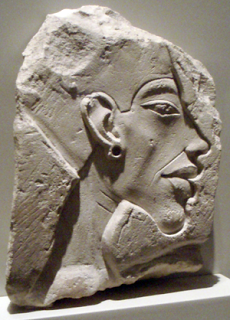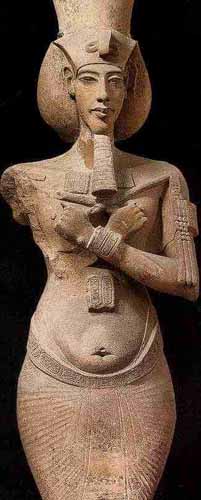Akhenaten
- Marian A.Ebrahim
- Jan 19, 2018
- 4 min read

The only Pharaoh whom you can recognize his statue easily .
Pharaoh Akhenaten was known as the Heretic King. He was the tenth King of the 18th Dynasty.
Akhenaten meaning "living spirit of Aten"
known before the fifth year of reign as Amenhotep IV (meaning Amun is Satisfied)
he is the son of Amenhotep III and Queen Tiye they had four daughters and two sons.
Akhenaten was not originally designated as the successor to the throne, seemed to be ignored by the rest of the family. He never appeared in any portraits and was never taken to public events. He received no honors. It was as if the God Amun had excluded him. He was rejected by the world for some unknown reason. He was never shown with his family nor mentioned on monuments.
, until the untimely death of his older brother, Thutmose. Amenhotep IV succeeded his father after Amenhotep III's death at the end of his 38-year reign, possibly after a short co-regency lasting between either 1 to 2 years.
In 1352 BC. Akhenaten ascended the throne, succeeding his father Amenhotep III who had died. Akhenaten was just a teenager at the time, but it was the desire of Queen Tiye that he rule.
His family his royal wife is queen Nefertiti from her he had six daughters , he also had other wives from one of them he had his son heir to the throne king Tutankhaton
Heretic king
Akhenaten is principally famous for his religious reforms, where the polytheism of Egypt was to be supplanted by monotheism centered around Aten, the god of the solar disc. This was possibly a move to lessen the political power of the Priests. Now the Pharaoh, not the priesthood, was the sole link between the people .
In the sixth year of his reign Akhenaten rejected the Gods of Thebes. They were never part of his childhood anyway since he had been shunned as a child. Akhenaten had declared for the first time in recorded history that there was only one God - the concept of monotheism. Overnight he turned 2,000 years of Egyptian religious upside down...
Akhenaten then sent his officials around to destroy Amun's statues and to desecrate the worship sites. These actions were so contrary to the traditional that opposition arose against him.
His capital
He felt guided by God Aton to change the capital of Egypt to Tell El Amarna in the middle of Egypt , in the modern Egyptian province of Minya
it's name was Akhetaten means "Horizon of the Aten."all his family and followers went with him to the new capital . he built his palaces , temples for Aton & his tomb their , unfortunately after his death they destroyed every thing built by him
Art during his reign All indications are that as a child Akhenaten was a family outcast. Scientists are studying the fact that Akhenaten suffered from a disease called Marfan Syndrome, a genetic defect that damages the body's connective tissue. Symptoms include, short torso, long head, neck, arms, hand and feet, pronounced collarbones, pot belly, heavy thighs, and poor muscle tone. Those who inherit it are often unusually tall and are likely to have weakened aortas that can rupture. They can die at an early age. If Akhnaton had the disease each of his daughters had a 50-50 change of inheriting it. That is why his daughters are shown with similar symptoms.
Akhenaten was the first Pharaoh to have images and paintings made of himself and his family, as they actually looked.
When Akhenaten built his monuments with images of the Pharaoh, he moved away from the traditions of a strong, handsome muscular Pharaoh. Images of Pharaohs with idealized bodies were gone. The Pharaoh was shown as misshapen as was his wife Nefertiti. It became fashionable to show images of the entire royal family with elongated heads, faces, fingers, toes, wide hips,
This gave the artists of Amarna new freedom to show scenes of the real life of the Pharaoh, something that had never been done before. The temple was covered with scenes of the Aten, the sun disc with its rays shining down, ending in hands holding ankhs, the hieroglyph for life. the images of the other Gods where not represented.
The end of his rule
Akhenaten lived in his dream in Amarna for ten years as conditions grew worse in Egypt. He remained isolated from the true problems of the people. Akhenaten apparently neglected foreign policy, allowing Egypt's captured territories to be taken back, though it seems likely that this image can be partially explained by the iconography of the time, which downplayed his role as warrior.
His tomb
Akhenaten had his tomb been built in tel el amarna his capital , but his tomb had been damaged after his death , they moved his coffin to a tomb in the valley of the kings
it's believed that tomb no. 55 in the valley of the kings in luxor is his tomb
This tomb was clearly unfinished, and the burial a hasty one. Gilded wooden inlay panels on the floor and against the wall. They bore the damaged image of Akhenaten worshiping the sun disc and the name of Queen Tiye.
In a niche were four beautiful alabaster jars that held the internal organs of the mummies. Lying on the floor was a badly damaged but beautiful coffin made with thousands of paste in-lays and semi-precious stones in the shape of protective wings. The cartouches containing the occupants name had been hacked out.
When they opened the coffin they found a mummy wrapped in gold-leaf. But as they touched the mummy it crumbled to dust leaving the excavators with a pile of dis-articulated bones at the bottom of the coffin. But beneath the skeleton, the last sheet of gold, seemed to have the damaged named of Akhenaten written on it.
the results of the research on the mummy show that he died between 45 and 50 years, the son of Amenhotep III and Queen T. indicating that he himself is Akhenaten."


















































Comments